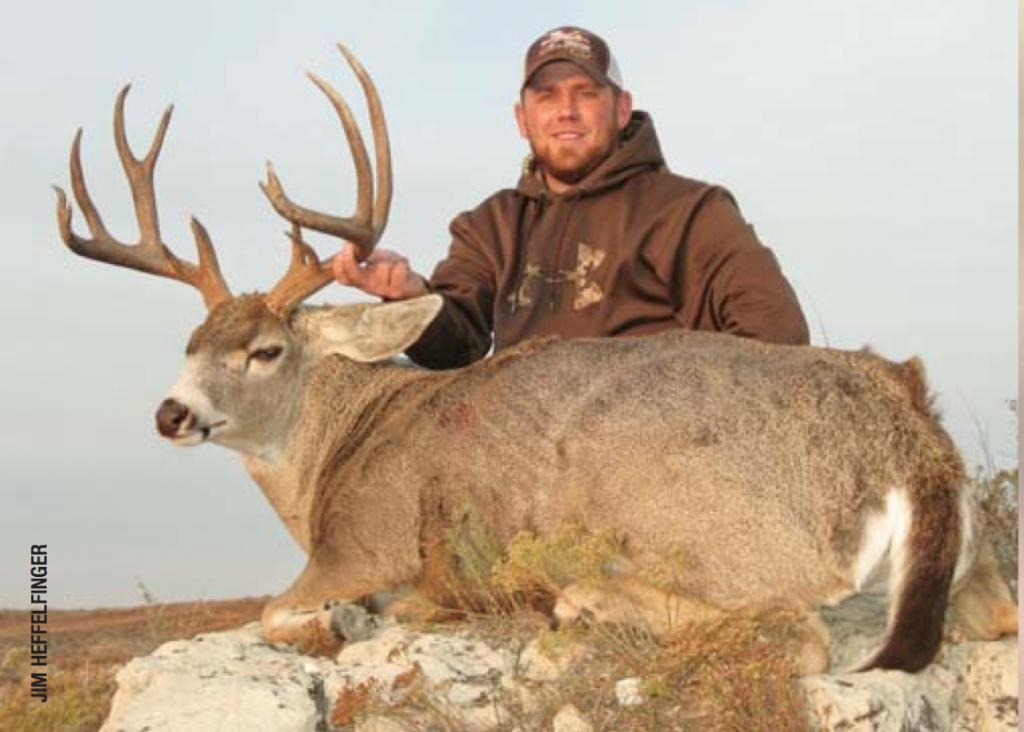A hunt here in Wisconsin was one for the ages for this bowhunter. The day was overcast, drizzly and super windy, but I decided to give it a try anyway. I settled into my ground blind at about 2:30 with hopes of seeing some turkeys or maybe a doe for the freezer. No turkeys showed up that afternoon, but several does did, and two of them (one in particular) were jumbos.
Two SEVR-tipped bolts from my TenPoint Nitro XRT put the two deer down with still a half-hour of daylight remaining. That was plenty of venison for this trip, so I packed up my gear and got on the bloodtrails.
The first doe only made it 50 yards from the blind. She was a 3-1/2-year-old blockhead of a nanny — deep chest, thick rounds and oh-so beautiful.
The celebration could have ended right there, but of course there was one more deer to track down. That bloodtrail, too, was short, but imagine my surprise when I saw precisely how big this second doe was:
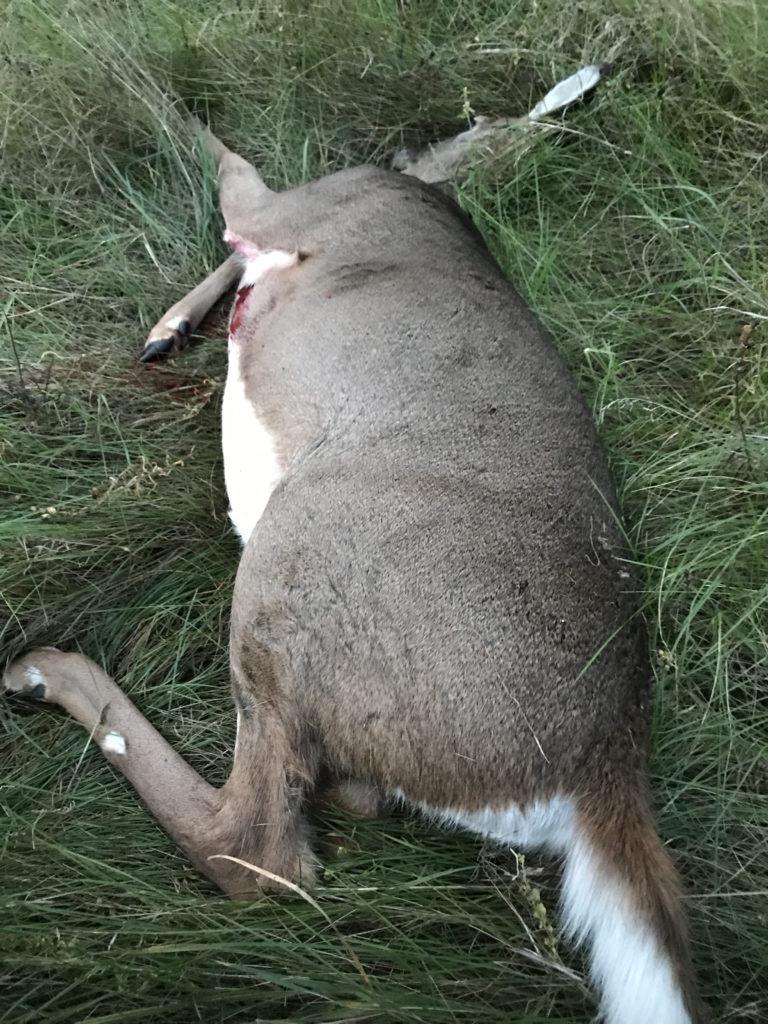
She was an absolute tank!
OK – short sidebar: Over all of these years of deer hunting (since 1983, to be exact), I have shot many, many deer, and lots of does. Lots of big does, too. I haven’t weighed all of them, but I have weighed more than my fair share (on legitimate scales). Only four of the does that I have killed during that time have weighed more than 130 field dressed (guts out — that’s how we do it “Up North”). My heaviest until last week was a 136-pound dressed nanny that I shot in north-central Wisconsin in the early 2000s.
The smaller of the two does that I shot last week weighed 125 pounds on the nose. The other one? Absolutely incredible: She weighed 156 pounds dressed! My biggest doe ever.
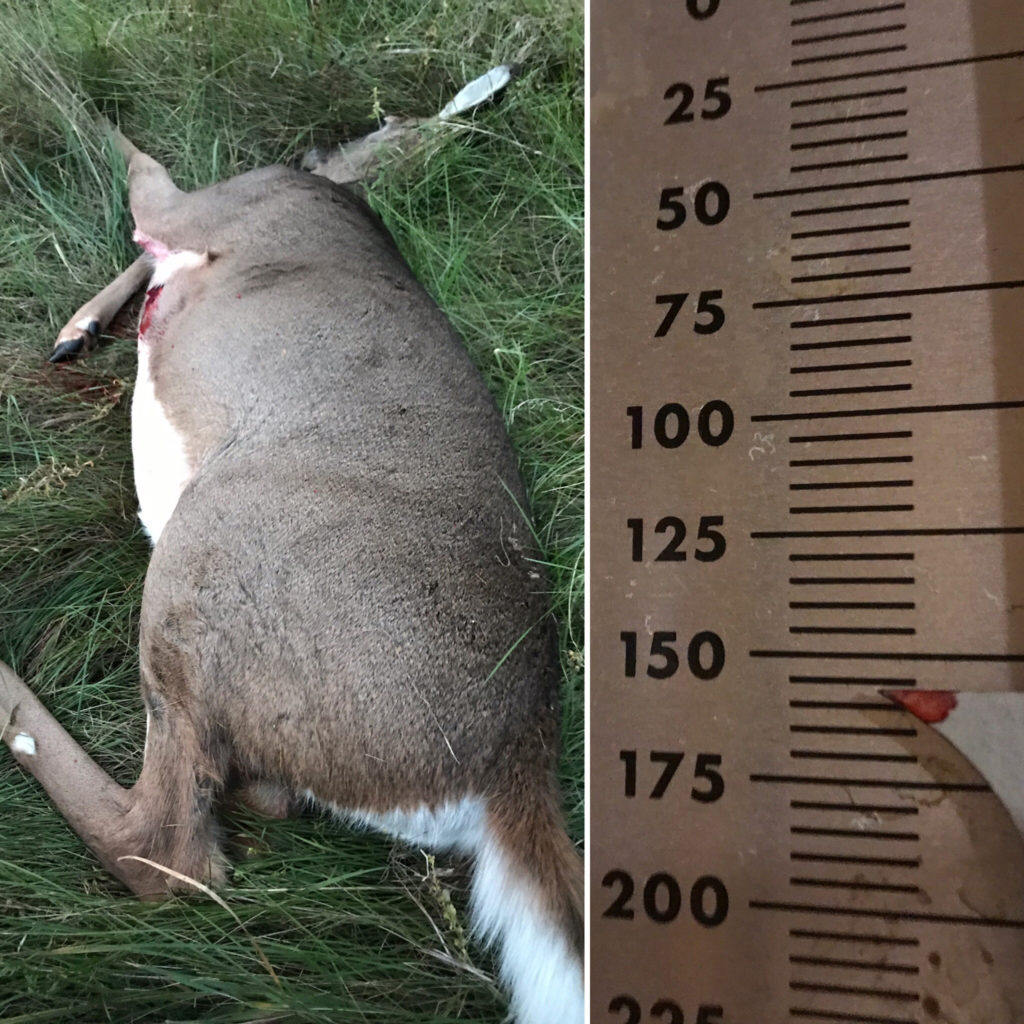
Does and bucks from similar age classes yield similar amounts of venison. You likely won’t see big differences in meat yields until you can compare a mature buck with the rest of the meat-pole crowd.
The typical Northern whitetail fawn, which includes “button bucks,” weighs about 55 to 75 pounds field dressed, while a healthy doe fawn weighs 45 to 65 pounds field dressed. Southern fawns weigh less — in fact, sometimes less than 30 pounds field dressed.
Yearling bucks, which range from small spikes to basket-racked 10-pointers, typically weigh 105 to 125 pounds.
The average mature Northern doe will typically weigh 105 to 120 pounds field dressed.
For decades, some hunters have relied on chest-girth charts to estimate live weights of deer. Unfortunately, such charts are often inaccurate because — among other things — they don’t account for fluctuations in the body sizes of bucks before and after the rut. Most biologists put no stock in any weight estimates based on chest-girth measurements.
A hunter can obtain a ball-park estimate of his deer’s live weight by multiplying its field-dressed weight by 1.28. My dad, Daniel J. Schmidt of Hubertus, Wisconsin, came up with this factor about 25 years ago after comparing it with several chest-girth charts and processing hundreds of deer (his father, J.F. Schmidt, started a meat processing company in 1930s that resulted in several generations of meat cutters).
The 1.28 ratio (or roughly 22 %) probably won’t pass muster with biologists, but we live in the real world. For that matter, it should be good enough for deer-camp comparisons. For example, a yearling buck with a field-dressed weight of 125 pounds will have an estimated live weight of 160 pounds.
Venison Misconceptions
By misjudging field-dressed weights of whitetails, hunters often have unrealistic expectations of how much venison they should receive from their butcher. Many aspects combine to determine venison yields. Although a neck-shot mature buck can yield a big amount of steaks, chops, hamburger and stew meat, the amount of meat seems minuscule when compared to the meat yield of domestic animals.
All animals are built a little different. For hogs, almost everything is used – bacon, hocks, etc. A deer has long legs with little meat on them, whereas steers have the same bone structure (but with more meat). It’s the muscle and fat that make them different.
Although it would be convenient to say a deer’s meat yield is equal to 50 percent of its field-dressed weight, it wouldn’t be totally accurate. A buck’s condition plays a large role in how much boneless venison it will yield.
Meat Yields (In Pounds)
Animal Weight* Meat Waste %Meat Lamb** 50 40 10 80% Hog 240 189 51 79% Black Angus 600 438 162 73% Holstein Steer 900 513 387 57% Mature Buck 180 72 108 40%
*Carcass weight. Head, hide and intestines removed
**University of Wisconsin research
BECOME A DDH INSIDER FOR FREE!
The Equation for Venison Yield
Hunters can learn more about their deer and how much venison it will yield by first obtaining an accurate field-dressed weight. This figure helps determine the deer’s carcass weight – the deer’s body weight minus its head, hide and innards. From there, it’s easy to calculate how much venison is on the carcass.
It’s important to note that this equation assumes that no part of the deer is lost to waste from tissue damage. Obviously, a deer suffering bullet – or to a lesser extent, arrow – damage to its back, hams, shoulders or neck will yield substantially less venison. Therefore, it includes calculations for “ideal” meat yield – the maximum amount of meat on a deer with nothing being lost to waste, and a “realistic” meat yield – the amount of meat a hunter can expect to receive after subtracting the pounds of meat lost to bullet/broadhead damage.
The equation does not account for meat that must be removed after being ruined by stomach contents or overexposure to warm weather.
Remember, to use the equation, first obtain an accurate field-dressed weight.
How Much Does it Weigh?
Mature white-tailed deer can be heavy, but much of their weight is distributed in non-meat areas. Here are some examples of how weight is distributed in Northern deer. (live weights in parenthesis)
Hide Factor
- Fawn: (100 pounds) 6.7 percent
- Adult doe: (140 pounds) 7.9 percent
- Adult buck (160 pounds) 8.7 percent
- Bucks: more than 160 pounds 9 percent
Bone Factor
- Fawn: (100 pounds) 13.8 percent
- Adult doe: (140 pounds) 13 percent
- Adult buck (160 pounds) 12.4 percent
- Bucks: more than 160 pounds 11.7 percent
Blood Factor
- Fawn: (100 pounds) 6 percent
- Adult doe: (140 pounds) 5 percent
- Adult buck (160 pounds) 5 percent
- Bucks: more than 160 pounds 5 percent
Using this guide as an example, a 180-pound buck would have 16.2 pounds of hide, 21.06 pounds of bones and 9 pounds of blood. Unfortunately, it’s difficult to estimate the live weight of a deer if it has been field-dressed because the weight of a deer’s innards varies depending on its health and diet.
— Pennsylvania State University, Department of Animal Science and the Pennsylvania Game Commission, 1968
- Carcass weight = Field-dressed weight divided by 1.331
- Ideal boneless venison weight = Carcass weight multiplied by .67
- Realistic venison yield = Ideal boneless weight multiplied by .70
Let’s say a hunter kills a mature buck, and it weighs 165 pounds field-dressed. Using the above equation, we estimate its carcass will weigh 124 pounds, and it will ideally yield 83.08 pounds of boneless meat. The deer’s realistic meat yield is about 58.15 pounds.
Because waste can vary between deer, we suggest using the “realistic” figure as a gauge. In the above example, the buck’s realistic meat yield would range form 58 to 68 pounds. A 10-pound difference doesn’t seem like much when dealing with a large deer , but it’s noticeable when the deer is a fawn or yearling.
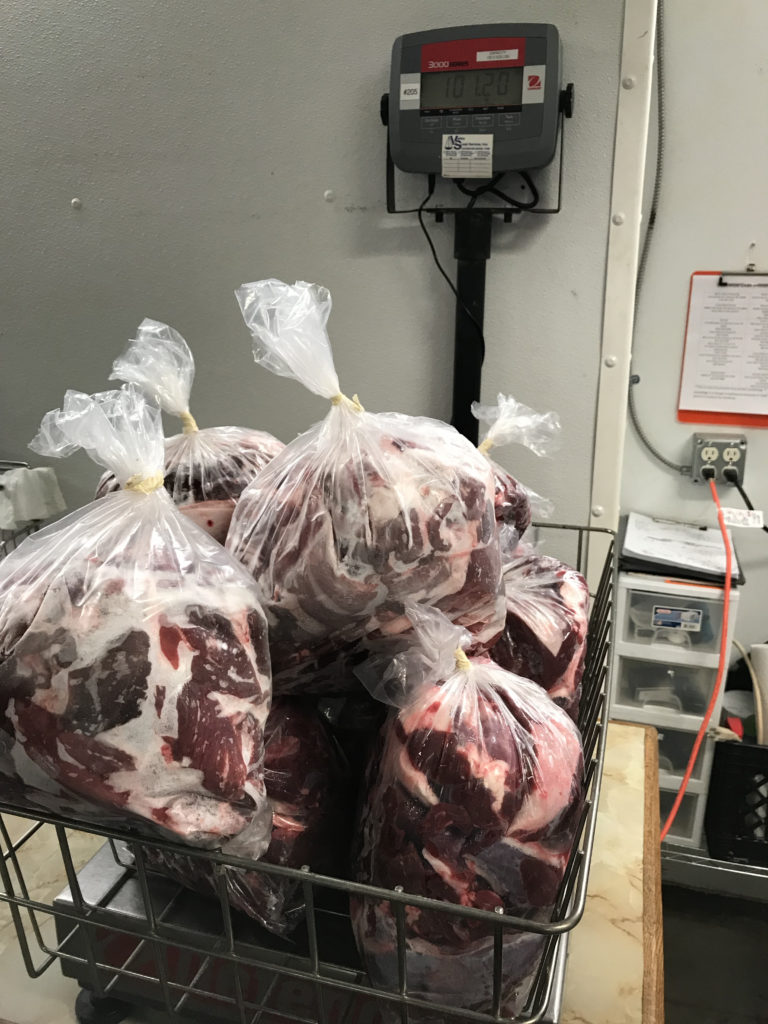
So, using these formulas on my big doe from last week, we get these results:
Doe 1:
Field-dressed weight = 156 pounds
Carcass weight = 117.2 pounds
Ideal boneless venison weight + 78.5 pounds
Realistic venison yield = 55 pounds.
Doe 2:
Field-dressed weight + 125 pounds
Carcass weight = 93.9 pounds
Ideal boneless venison weight = 62.9 pounds
Realistic venison yield = 44.0 pounds
As you can tell, the realistic yield is very conservative. Combined, both of those deer should have realistically yielded 99.04 pounds of boneless venison. The very best scenario would have brought the number in at 141 pounds.
Thankfully, the shots and field dressing efforts were nearly perfect. I had both deer processed by a friend (who happens to be a professional butcher), and although we did not separate the two deer, we did weigh all of the boneless venison after it was wrapped and frozen. Combined, these two deer netted my family 124 pounds of venison — not quite “ideal” but also quite a bit better than the realistic number.
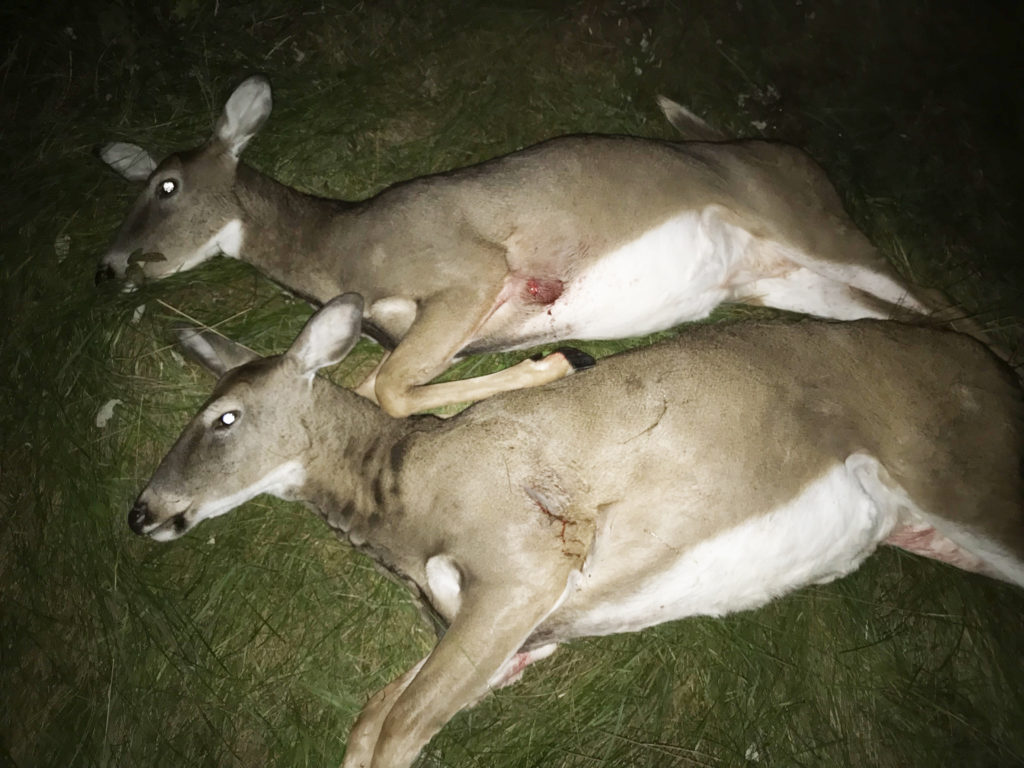
Venison Conclusions
In most cases, hunters will likely see little difference in meat yields between the deer they shoot. Does and bucks from similar age classes yield similar amounts of venison. In fact, don’t expect to see big differences in your net venison yield unless you’re comparing relatively young deer with a big, mature, deep-chested buck.
BECOME A DDH INSIDER FOR FREE!
ALL TEXT AND PHOTOS COPYRIGHT 2019, MEDIA 360 LLC. ALL RIGHTS RESERVED.


